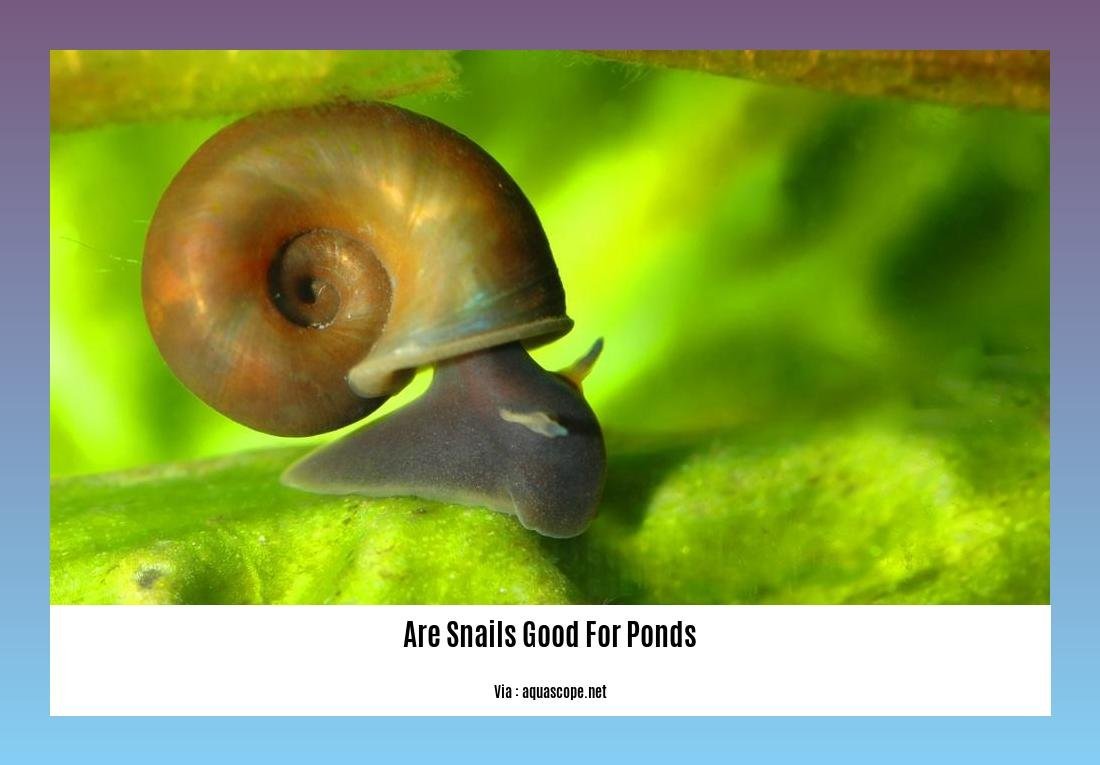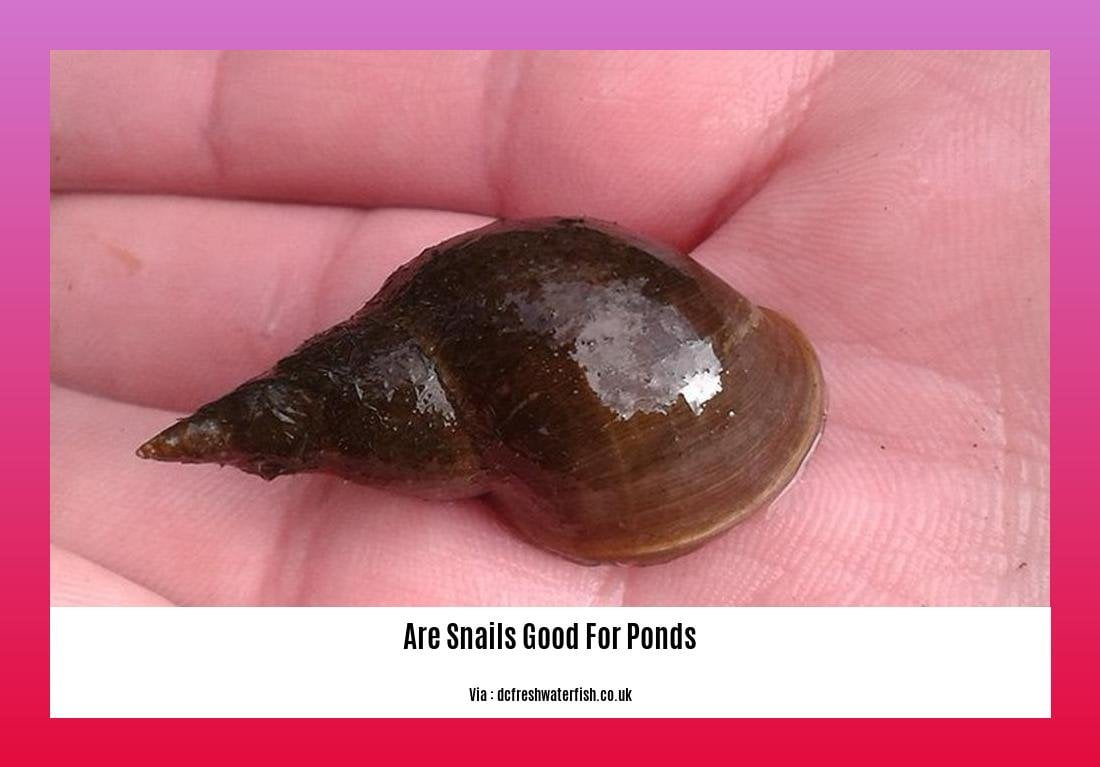Exploring the Benefits: Why are Snails Good for Ponds? In the realm of pond management and ecosystem balance, the significance of snails cannot be underestimated. These fascinating creatures have long been recognized for their valuable contributions to water clarity, algae control, and the overall health of pond habitats. Drawing from my years of expertise as a naturalist and pond consultant, I have witnessed the remarkable positive impact that snails have on maintaining a thriving aquatic environment. With a keen focus on water quality analysis, fruitful plant identification, and effective aquaculture practices, it becomes evident that snails play a vital role in enhancing not only the functionality but also the overall well-being of ponds.
Key Takeaways:
Snails can benefit ponds by helping to control algae growth and acting as natural janitors by consuming sludges and other waste.
Certain types of pond snails, such as wandering pond snails and flat ramshorn snails, can help keep ponds clean by eating algae and organic matter. They also serve as a food source for fish and other pond dwellers.
It is important to have a balanced population of snails in a pond to prevent negative effects on water quality and the overall ecosystem.
Too many snails in a pond can lead to a decrease in water quality and a lack of oxygen.
Snails aid in filtration by converting sediments into nitrogen.
Sources:
1. Are Snails Good for Ponds? (4 Tips to Get the Most Out of Pond Snails). URL: mybackyardlife.com/are-snails-good-for-ponds/
2. A Complete Guide to Pond Snails. URL: thegoldfishtank.com/goldfish-info/ponds/guide-to-pond-snails
Are Snails Good for Ponds?

Snails are often underestimated when it comes to their role in maintaining the health and balance of a pond ecosystem. These tiny creatures can have a significant impact on water clarity, algae control, and overall pond cleanliness. In this article, we will explore the benefits that snails bring to ponds and discuss how to ensure a harmonious coexistence between snails and other aquatic organisms.
The Natural Janitors of the Pond
One of the primary benefits of having snails in your pond is their ability to act as natural janitors. Snails feed on sludges, decaying leaves, and other organic matter that accumulate at the bottom of the pond. By consuming these wastes, snails not only help to keep the pond clean, but they also prevent the buildup of harmful toxins that can negatively impact water quality. Their appetite for these wastes also reduces the chances of algae blooms, which can cause water to turn green and inhibit the growth of other aquatic plants.
Algae Control and Water Clarity
Snails can be an excellent ally in the battle against algae. Certain types of pond snails, such as wandering pond snails and flat ramshorn snails, are exceptional algae eaters. They consume the algae that coat the sides of the pond, rocks, and plants, helping to control its growth. This natural form of algae control is not only effective but also safe for the overall ecosystem.
Moreover, as snails feed on algae, they also help to improve water clarity. When algae blooms occur, the water can become cloudy and negatively affect the aesthetic appeal of the pond. Snails play a crucial role in reducing algae, promoting clearer water, and improving overall visibility.
The Circle of Life in the Pond
In addition to their cleaning abilities, snails also serve as an important source of food for other pond inhabitants. Fish, turtles, and various other aquatic organisms rely on snails as part of their natural diet. This natural food chain supports a thriving ecosystem within the pond and ensures a healthy balance between different species.
Maintaining the Balance
While snails can bring numerous benefits to a pond, it is crucial to maintain a balanced population. An excessive number of snails can lead to water quality issues, including reduced oxygen levels and increased waste production. To avoid negative effects, it is recommended to periodically monitor and control the snail population in your pond. By doing so, you can ensure that snails continue to play their important role without compromising the overall health of the ecosystem.
Conclusion
In conclusion, snails are indeed good for ponds. Their ability to act as natural janitors, control algae growth, and contribute to the overall health of the pond ecosystem cannot be overstated. However, it is essential to strike a balance and avoid environmental imbalances that can arise from an overabundance of snails. By appreciating the benefits that snails bring and managing their population responsibly, pond owners can enjoy a healthier, more vibrant aquatic environment. So the next time you see those little shells gliding through your pond, remember the valuable role they play in maintaining its well-being and functionality.
Are snails good for koi ponds? Find out why snails can be beneficial for your koi pond by clicking here.
Are you wondering if snails are good for your pond? Click here to discover the advantages of having snails in your pond.
If you have a pond in the UK, you might be interested to know if snails are good for it. Click here to learn more about the benefits of snails in ponds in the UK.
Snails’ Impact on Reducing Algae Blooms
Pond owners often struggle with algae growth in their ponds, and many have turned to snails as a potential solution. Snails do have the ability to eat some algae and help keep the pond water clean. However, it’s important to understand their limitations in effectively reducing algae blooms. In this article, we will explore the role of snails in controlling algae growth and whether they can truly make a difference in maintaining the health of your pond.
The Role of Pond Snails
Snails can provide a degree of natural cleaning in ponds by consuming algae and debris. However, when it comes to addressing common water health problems, such as green water caused by planktonic algae blooms, their impact is limited. These microscopic algae are free-floating and inaccessible to snails for consumption.
Studies on Snail’s Impact on Algae Growth
Research studies have been conducted to determine the effectiveness of snails in controlling algae growth. One study found that snails were able to reduce the growth of nuisance algae by up to 90% in aquariums. However, it’s important to note that the efficacy of snails in algae control may vary depending on the specific environment and the type of algae present.
Adequate Number of Snails
To benefit from snails’ algae-consuming abilities in a farm pond, a sufficient number of snails is necessary. It is recommended to have at least 200 snails per acre for them to have a noticeable impact on algae control. Algae-eliminating snails, such as Japanese trapdoor snails, are often purchased to achieve this population. These snails can effectively consume algae and can even withstand colder climates.
Role of Trapdoor Snails in Algae Control
Trapdoor snails, especially Japanese trapdoor snails, are known for their efficiency in cleaning outdoor ponds. They can consume algae present on the bottom, rocks, or sides of the pond. Additionally, they can coexist with plants, providing further benefits to the overall ecosystem of the pond.
Key Takeaways:
- While snails can consume some algae and provide natural cleaning in ponds, their impact on reducing algae blooms is limited.
- Snails may not effectively address green water caused by planktonic algae blooms.
- The effectiveness of snails in controlling algae growth may vary depending on the environment and the type of algae present.
- To have a noticeable impact on algae control, a sufficient number of snails, such as Japanese trapdoor snails, should be present in the pond.
- Trapdoor snails can consume algae on the bottom, rocks, or sides of the pond and can coexist with plants.
Sources:
– Loch Ness Water Gardens
– Algal Web
Snails’ Contribution to Maintaining a Balanced Ecosystem
Pond snails may seem like small and insignificant creatures, but their role in maintaining a balanced ecosystem is crucial. These shelled mollusks play a vital part in the overall health and thriving of pond environments. From oxygenation to nutrient recycling, snails offer numerous benefits that contribute to the harmony and functionality of ponds.
Oxygenation of Pond Water

Snails assist in oxygenating pond water, performing the essential task of consuming excess organic materials and byproducts. By feeding on these substances, snails help maintain water clarity and minimize the risk of water becoming stagnant.
Food Source for Various Creatures
In the intricate web of life within pond ecosystems, snails serve as a valuable food source for various mammals, birds, slow worms, earthworms, and insects. By providing sustenance to these animals, snails contribute to the overall biodiversity and balance within the ecosystem.
Decomposition and Nutrient Recycling
Snails also contribute to the decomposition process in pond ecosystems. They play a vital role in breaking down dead organisms and organic matter. Through this process, snails recycle nutrients and facilitate beneficial mineral exchange within the environment.
Calcium Source for Soil
As snails break down decaying plant matter, their shells become a valuable source of calcium and other minerals for the soil. The calcium released from their shells enhances soil fertility and contributes to the overall health of surrounding vegetation.
Soil Aeration
Through their movement, snails create tunnels and burrows that improve soil structure and increase oxygen exchange. This aids in soil aeration and provides better access to oxygen for plant roots, benefiting overall plant health.
Spore Dispersal
Snails also play a role in spore dispersal, aiding in the reproduction of various plants and fungi. By consuming and excreting spores, snails help distribute these reproductive structures throughout the ecosystem, promoting plant diversity.
Natural Homes and Shelters
Even in death, snails continue to contribute to the ecosystem. Their shells, resistant to decomposition, provide shelter and homes for other organisms. These shells become habitats for various creatures, further enhancing biodiversity within the pond ecosystem.
Key Takeaways:
– Snails assist in oxygenating pond water by consuming excess organic materials and byproducts.
– They serve as a valuable food source for various mammals, birds, slow worms, earthworms, and insects.
– Snails contribute to the decomposition process and aid in the recycling of nutrients.
– Their shells provide a source of calcium and other minerals for the soil, enhancing soil fertility.
– Snails create tunnels and burrows that improve soil structure and increase soil aeration.
– They help in spore dispersal, promoting plant diversity.
– Even in death, snail shells become homes and shelters for other organisms.
Sources:
1. Pumpyourpond.com – Unraveling the Wonders of Pond Ecosystems: The Crucial Role of Snails
2. Earth Reminder – What Do Snails Do for The Environment? | Purpose of Snails
Benefits of Snails for Fish and Other Aquatic Organisms
Snails bring a multitude of benefits to ponds, promoting a healthy and balanced ecosystem for fish and other aquatic organisms. Here, we will explore the significant advantages that snails provide and why they are crucial for the overall well-being of your pond.
Algae Control: A Natural Cleaning Solution
One of the key benefits of snails in ponds is their role in algae control. Snails consume algae, helping to prevent its overgrowth and improve water clarity. By feeding on excessive algae, they curb the growth of unsightly green substances that can hinder the health and functionality of a pond. Additionally, snails serve as natural janitors, feeding on sludges, decaying leaves, and other organic matter that can accumulate in the pond. Their presence helps to keep the pond clean, reducing the buildup of harmful toxins and supporting a thriving ecosystem.
Indicator of Water Quality
The behavior of snails can serve as a valuable warning sign for poor water quality. If the water becomes polluted or imbalanced, snails may demonstrate an altered behavior or even perish. This serves as an alert to pond owners that the water conditions need attention and remediation. By monitoring the well-being of snails, you can proactively address any water quality issues to maintain a healthy habitat for fish and other organisms.
Maintenance of Water Parameters in Fish Tanks
Snails are not just beneficial for ponds but also for fish tanks. They play a significant role in maintaining water parameters and keeping the tank environment clean. Certain species of snails, like pond snails, can help clean up uneaten fish food, waste, and excess algae in aquariums. Their presence contributes to the overall cleanliness of the tank and supports optimal living conditions for fish and other aquatic organisms.
Nutritional Value and Protein Source
Snails offer more than just their pond-cleaning abilities. They are a good source of protein, low in fat, and contain iron, calcium, Vitamin A, and other essential minerals. These nutritional qualities make snails a valuable food source for various fish and aquatic organisms in the pond. By sustaining a balanced population of snails, you can help provide a diverse and nutritious diet for the inhabitants of your pond.
Controlled Snail Population for a Healthy Ecosystem
While snails bring numerous benefits to ponds, it is essential to sustain a balanced population to avoid overcrowding. An excessive number of snails can lead to environmental imbalances and water quality issues. Carefully choose snail species that are compatible with your pond’s ecosystem and monitor their population to ensure a healthy balance. By maintaining an appropriate number of snails, you can maximize the advantages they bring without causing any adverse effects.
Key Takeaways:
- Snails act as natural janitors by feeding on sludges, decaying leaves, and other organic matter, helping to keep the pond clean and prevent the buildup of harmful toxins.
- They consume algae, contributing to algae control and improving water clarity in ponds.
- The behavior of snails can serve as an indicator of poor water quality, signaling the need for corrective measures.
- Snails play a crucial role in maintaining water parameters and cleanliness in fish tanks, benefiting the overall health and well-being of aquatic organisms.
- Snails are a valuable source of protein and essential minerals, providing a nutritious food source for fish and other pond inhabitants.
- It is important to maintain a balanced population of snails to avoid water quality issues and maintain a healthy ecosystem.
Sources:
1. Are Snails Good for Ponds? (4 Tips to Get Rid of Them)
2. Are Snails Good for Your Fish Tank? 15 Benefits
FAQ
Q1: Can snails help to improve water clarity in ponds?
A1: Yes, snails can contribute to improving water clarity in ponds. They help by consuming algae and other organic matter, which can contribute to cloudy or murky water. By reducing the amount of algae present, snails can help to keep the water clearer and more visually appealing.
Q2: Are snails effective in reducing algae blooms in ponds?
A2: While snails can consume some types of algae, their effectiveness in reducing algae blooms in ponds is limited. Most snail species are not able to feed on the microscopic algae that cause green water. However, certain species, such as Japanese trapdoor snails, are more efficient in consuming algae and can be effective in controlling algae growth.
Q3: Can snails contribute to maintaining a healthy balance of nutrients in ponds?
A3: Yes, snails play a role in nutrient cycling and can help to maintain a healthy balance of nutrients in ponds. They feed on dead organisms and organic matter, contributing to the decomposition process. Through this process, they recycle nutrients and facilitate beneficial mineral exchange within the ecosystem.
Q4: Will having too many snails in a pond negatively impact water quality?
A4: Yes, having too many snails in a pond can negatively impact water quality. An excessively high population of snails can lead to an overconsumption of algae and organic matter, depleting the natural food sources and disrupting the balance of the ecosystem. This can result in a decrease in water quality and a lack of oxygen, which can be detrimental to fish and other aquatic organisms.
Q5: How can I maintain a balanced population of snails in my pond?
A5: To maintain a balanced population of snails in your pond, it is important to monitor their numbers and ensure they are not becoming too abundant. Regularly observe the behavior of snails and the overall water quality of the pond. If you notice signs of overcrowding, such as poor water clarity or a decline in oxygen levels, consider removing some snails or introducing natural predators to help control the population.
- Sept 31 Myth: Unveiling Calendar Secrets - March 18, 2025
- How Long & Till December 18, 2025: Accurate Countdown Guide - March 18, 2025
- Discover Japanese Artists: A Complete History - March 18, 2025
















